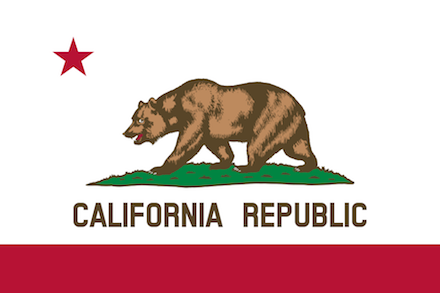This date’s anecdote, from a public domain local history, concerns the April 24, 1852 hanging of Nathaniel Bowman. Bowman has the minor distinction of being the first person executed in California’s Colusa County.
Bowman would not escape his execution but his attempt to do so summoned the offices of William B. Ide, a pioneer who had led a revolt in Mexico’s Alta California and thereafter headed the very short-lived California Republic — an affair sometimes remembered as the “Bear Flag Revolt” for the sigil still used today by the state.

The present-day California flag.
The service Ide would render his countrymen in this post was among the last of his life: he died of smallpox later in 1852.
The first legal execution in Colusa County occurred in the spring of 1852. Nathaniel Bowman was convicted of murder in the first degree for killing Levi Seigler by beating him over the head with a bottle.*
There was no jail then, and during the trial Bowman was placed under guard at Monroeville. After his conviction he nearly made good his escape. In some manner he eluded the vigilance of his guard and, still shackled, hobbled to the home of Jesse Sheppard, where he begged piteously to have his irons filed off. Sheppard, however, took him back and turned him over to the authorities at Monroeville, where he was executed soon afterwards.
This episode clearly showed the necessity of having some safe place of detention for prisoners.
With his characteristic resourcefulness in emergencies, William B. Ide met this situation also. He obtained some bar iron and bolts from San Francisco and fashioned a cage. This he placed in the shade of a great oak in front of the hotel in Monroeville, which did duty at that time as the county courthouse also. This simple expedient solved the problem until the seat of government was transferred to Colusa in 1854, whereupon Ide’s cage was removed also, to continue duty as a cell in the county jail in Colusa.
* The Sacramento News (April 27, 1852) advises that Bowman “addressed the assembled crowd, from the scaffold, and stated that it was not his intention to kill Seigler, but to beat him badly.”
On this day..
- 1935: Three Venizelist officers
- 1821: Athanasios Diakos, Greek War of Independence hero
- 1752: Nicholas Mooney, penitent thief
- 1889: William Henry Bury, Jack the Ripper suspect
- 1751: Anna Schnidenwind, the last witch in Baden-Württemberg
- 1922: Colin Campbell Ross, for the Gun Alley Murder
- 1998: 22 for the Rwanda genocide
- 1945: A day in the death penalty around the Reich
- 1655: Massacre of Waldensians
- 1723: Major Jean Abram Davel
- 1521: The Comuneros of Castile
- 1868: John Millian, who martyred a madam
